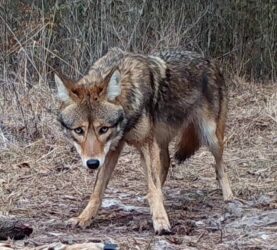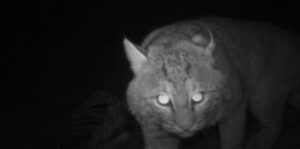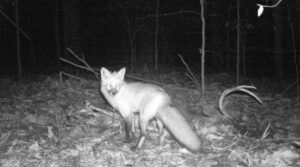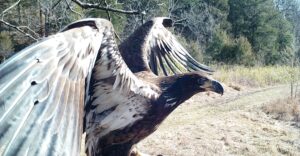By Bernheim
 Since 2008 Bernheim Forest has been partnering with researchers to track golden eagles, eventually leading to an understanding that we are following a breeding pair of golden eagles. These two apex predators travel nearly 1700 miles every year from northern Canada directly to the large, intact forest of Bernheim to spend the winter. If you’ve followed this story, it’s likely that you’ve seen some incredible images of these majestic birds of prey in Bernheim Forest. What you likely haven’t seen is the abundance and diversity of other wildlife that are documented in the process of studying the eagles!
Since 2008 Bernheim Forest has been partnering with researchers to track golden eagles, eventually leading to an understanding that we are following a breeding pair of golden eagles. These two apex predators travel nearly 1700 miles every year from northern Canada directly to the large, intact forest of Bernheim to spend the winter. If you’ve followed this story, it’s likely that you’ve seen some incredible images of these majestic birds of prey in Bernheim Forest. What you likely haven’t seen is the abundance and diversity of other wildlife that are documented in the process of studying the eagles!
To capture these amazing images, we installed motion-detecting cameras deep within Bernheim Forest. These birds are weary of humans and are extremely difficult to see or photograph in person. The motion-triggered cameras allowed us to capture high-quality, candid photos not only of Harper and Athena, the breeding pair of golden eagles that are being tracked, but also other animals that call Bernheim home. Over the course of the several months, we were able to capture photos of unidentified golden eagles, bald eagles, hawks, coyote, fox, and bobcat.

Pictured to the left is a coyote (Canis latrans) that became known as Tawny, named for her rust colored fur. Her expressive face and unique markings made it possible to identify her through a series of photographs in this camera location.
Over the past two centuries, coyotes like Tawny have largely been misunderstood and persecuted as pests, nuisances, and threats to humans. The reality is that coyote play an important ecological role, not only in large forest blocks such as Bernheim, but also in smaller natural areas, wildlife refugia, the outskirts of human activity, and even deep within urban areas.
A Cornell University study finds that 30% of birds have vanished from the United State and Canada since 1970. Large contributors to this decline are loss of habitat and feral cats preying on songbirds. Research has shown that the presence of coyote in a protected habitat may increase songbird populations by controlling cat populations. These wild canines play a beneficial role as a large predator within Bernheim, where they prey on smaller mammals and deer fawns, providing some balance within the food chain.


Bernheim Forest is also home to some very charismatic species that play similar ecological roles as coyotes. Pictured to the right is a bobcat (Lynx rufus) and to the left, a red fox (Vulpes vulpes). Much like the golden eagles, these elusive, enigmatic creatures are very private. Their private nature combined with their nocturnal activities makes them particularly hard to spot, let alone photograph. They feed upon prey species such as rabbit, squirrel, and mice, which is beneficial within the food chain and helps maintain ecological balance within the forest.

Land dwelling animals aren’t the only species we photographed with our motion-detecting cameras. We have learned that the wilderness deep within Bernheim Forest is appealing to more than just the golden eagles. Pictured to the right is a juvenile bald eagle. These iconic, large birds of prey share, not always amicably, some of the same territory as Harper and Athena.
The wealth of large fauna in Bernheim Forest is a testament to the importance of large, intact forest blocks. Bernheim provides a mosaic of habitats, including forest, wetland, prairie, glade, and stream, to the wildlife that reside here. This habitat diversity cultivates strong, resilient wildlife populations within our forest. Bernheim staff work hard every day to protect and enhance these habitats and the wildlife within them.
To learn more about the plants and animals that call Bernheim home, follow us on Facebook and Instagram @Bernheimforest.

